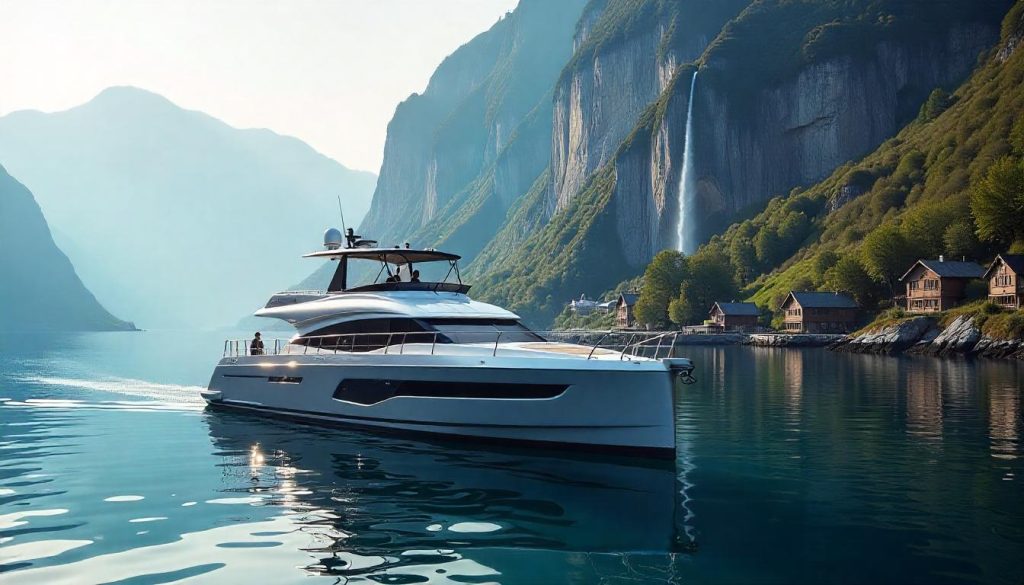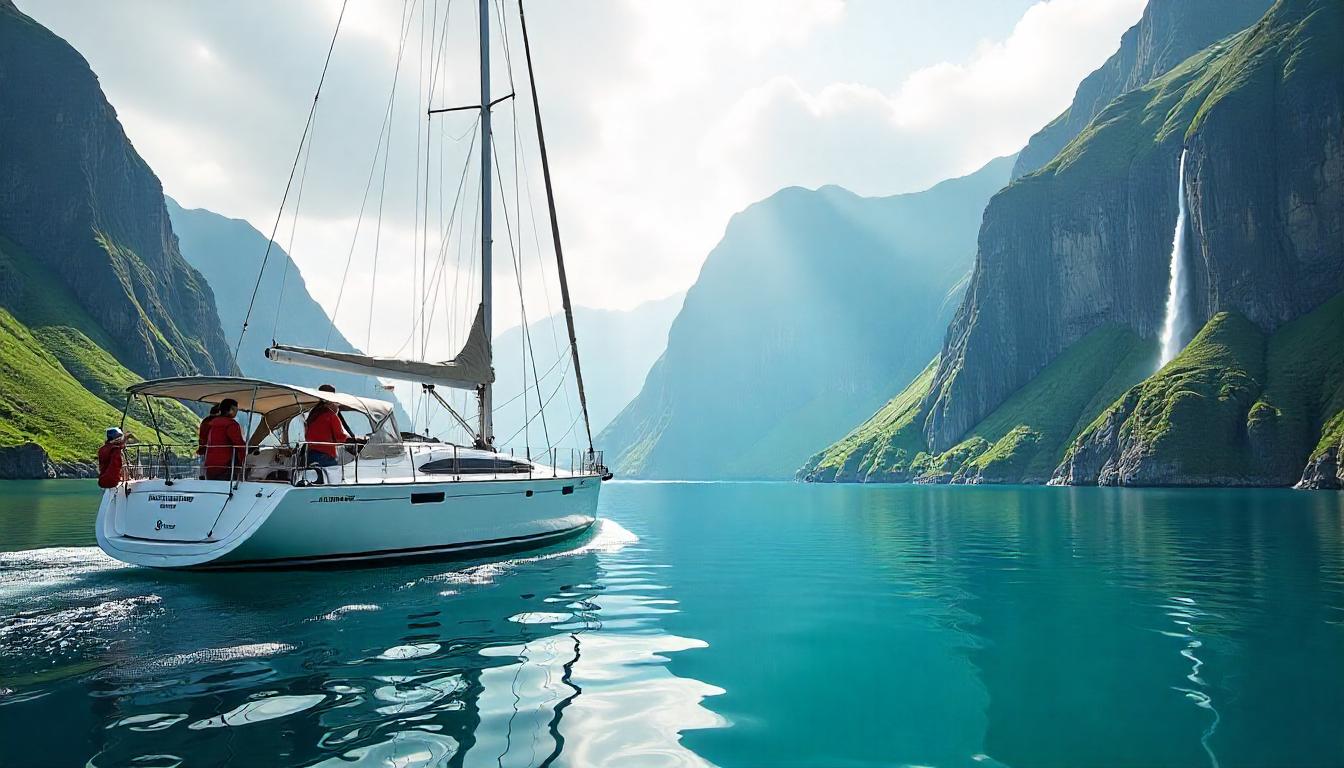The Norwegian Fjords, carved by glaciers over millennia, offer a dramatic sailing experience, and Norwegian Fjords sailing in 2025 promises an adventure amidst towering cliffs and serene waters. Stretching along Norway’s western coast, these fjords span over 1,000 miles, with some reaching depths of 1,300 meters, per geological data. From the UNESCO-listed Geirangerfjord to the expansive Sognefjord, the region combines natural beauty with challenging navigation. In this guide, we’ll explore top routes, highlight must-visit fjords, and share practical tips for sailors. Let’s embark on a journey through Norway’s stunning waterways.
Bergen: The Starting Point for Norwegian Fjords Sailing
Bergen, known as the gateway to the fjords, is an ideal starting point for Norwegian Fjords sailing. This historic city offers a well-equipped marina for yachters. For example, Bergen Marina accommodates yachts up to 50 meters. It has 70 berths and depths of 5-7 meters, per port data. Also, the marina provides fuel and provisioning services. You can explore the Bryggen wharf, a UNESCO site, with colorful wooden buildings. Local cafes there serve cinnamon buns for $5, per menus. The area’s winds average 8 knots, per forecasts. Thus, Bergen sets the stage for an exciting sailing journey.
Bryggen Wharf: A Cultural Stop in Bergen
Bryggen Wharf in Bergen offers a cultural stop for sailors starting their fjord journey. A short walk from Bergen Marina brings you to this historic site. For instance, the wharf’s wooden buildings date back to the 14th century. Entry to the Bryggen Museum costs $10, showcasing Hanseatic artifacts, per guides. Also, the area’s fish market sells smoked salmon for $15 per kilo, per vendors. You can enjoy a coffee at a nearby café for $4, with views of the harbor, per menus. Moreover, the wharf’s cobblestone streets add a medieval charm to your visit. This cultural gem makes Bryggen a highlight. Therefore, it’s a great way to begin your trip in Bergen.
Vågen Harbour: A Scenic Anchorage in Bergen
Vågen Harbour, near Bergen’s center, provides a scenic anchorage for sailors. Anchor in depths of 4-6 meters, suitable for yachts up to 40 meters, per charts. For example, the harbor’s waters are calm, with temperatures averaging 10°C, per reports. Also, the surrounding hills offer a stunning backdrop, especially at sunrise, per local guides. You can tender to shore for $10 per day, per operators. The nearby Torget market sells fresh shrimp for $20 per kilo, per vendors. Additionally, the harbor’s proximity to Bergen Aquarium, with entry at $15, adds a family-friendly activity, per guides. This scenic spot makes Vågen Harbour a standout. Thus, it’s a perfect stop before heading to the fjords.
Sognefjord: The King of Norwegian Fjords Sailing
Sognefjord, Norway’s longest and deepest fjord, is a centerpiece for Norwegian Fjords sailing, stretching 205 kilometers inland. Begin in Balestrand, a charming village with a small marina. Kviknes Marina in Balestrand accommodates yachts up to 40 meters. It has depths of 4-6 meters, per port data. For instance, berthing fees average $50 per night for a 40-meter yacht. Amenities include fuel, per tariffs. Also, Balestrand’s cafes serve waffles with sour cream for $8, a local specialty, per menus. The fjord’s winds average 5 knots, per forecasts. Thus, Sognefjord offers a majestic sailing experience.
Flåm: A Picturesque Village in Sognefjord
Flåm, a village in Sognefjord, offers a picturesque stop for sailors. Anchor near Flåm Harbour in depths of 5-7 meters, suitable for yachts up to 50 meters, per data. For example, the surrounding cliffs rise 1,400 meters, creating a dramatic view, per guides. Also, the Flåm Railway, one of the world’s steepest, costs $60 per person for a round trip, per operators. The train ride offers views of waterfalls like Kjosfossen. You can visit the Flåm Museum for free, learning about the railway’s history, per guides. Moreover, local eateries serve reindeer stew for $25, per menus. This scenic village makes Flåm a highlight. Therefore, it’s a must-visit in Sognefjord.
Aurlandsfjord: A Quiet Arm of Sognefjord
Aurlandsfjord, a branch of Sognefjord, provides a quiet retreat for sailors. Navigate carefully, as depths can drop to 10 meters near cliffs, per charts. For instance, the fjord’s waters average 9°C, with visibility up to 15 meters, per reports. Also, the Stegastein Viewpoint, accessible by tender and a short drive, offers panoramic views, with entry at $5, per guides. You can spot mountain goats on the cliffs, a common sight, per locals. Additionally, the fjord’s calm waters and winds averaging 4 knots ensure a peaceful sail, per forecasts. This tranquil spot makes Aurlandsfjord a standout. Thus, it’s a great detour for sailors seeking serenity in Sognefjord.

Geirangerfjord: A UNESCO Gem for Norwegian Fjords Sailing
Geirangerfjord, a UNESCO World Heritage site, is a gem for Norwegian Fjords sailing, known for its dramatic scenery. Start in Geiranger, a small village with a marina. Geiranger Marina accommodates yachts up to 40 meters. It has depths of 4-6 meters, per port data. For example, berthing fees average $60 per night for a 40-meter yacht. Amenities include fuel and Wi-Fi, per tariffs. Also, the village’s bakery sells skillingsboller, a cinnamon pastry, for $4, per menus. The fjord’s winds average 5 knots, per forecasts. Thus, Geirangerfjord is a breathtaking destination for sailors.
Seven Sisters Waterfall: A Natural Wonder
The Seven Sisters Waterfall in Geirangerfjord offers a natural wonder for sailors. Sail close to the falls, which drop 250 meters into the fjord, per data. For instance, the falls are best viewed in June, when snowmelt creates a powerful flow, per guides. Also, the fjord’s waters average 8°C, with visibility up to 10 meters, per reports. You can anchor nearby in depths of 5-7 meters, suitable for yachts up to 40 meters, per charts. The surrounding cliffs, rising 1,000 meters, create a stunning backdrop, per locals. Moreover, the area’s calm waters ensure a safe stop, per forecasts. This majestic waterfall makes Seven Sisters a highlight. Therefore, it’s a must-see in Geirangerfjord.
Flydalsjuvet Viewpoint: A Scenic Overlook
Flydalsjuvet Viewpoint, above Geirangerfjord, provides a scenic overlook for sailors. Tender to Geiranger and take a 15-minute taxi ride for $20, per operators. For example, the viewpoint offers panoramic views of the fjord, with the Seven Sisters visible, per guides. Also, a rock platform, often photographed, juts out over the fjord, with no entry fee, per locals. You should wear sturdy shoes, as the path can be slippery, per advice. Additionally, the early morning light casts a golden glow over the fjord, enhancing the view, per locals. This stunning spot makes Flydalsjuvet a standout. Thus, it’s a great detour for sailors in Geirangerfjord.
Hardangerfjord: A Fruitful Route for Sailors
Hardangerfjord, known for its orchards, offers a fruitful route for sailors exploring the fjords. Begin in Ulvik, a peaceful village with a small marina. Ulvik Marina accommodates yachts up to 40 meters. It has depths of 4-6 meters, per data. For instance, berthing fees average $45 per night for a 40-meter yacht. Amenities include fuel, per tariffs. Also, Ulvik’s orchards produce apples for cider, sold at $10 per bottle, per vendors. The fjord’s winds average 6 knots, per forecasts. Thus, Hardangerfjord is a delightful sailing destination.
Folgefonna Glacier: A Glacial Adventure
Folgefonna Glacier, near Hardangerfjord, offers a glacial adventure for sailors. Tender to Odda and join a guided tour for $80 per person, per operators. For example, the glacier spans 207 square kilometers, one of Norway’s largest, per data. Also, the tour includes a hike on the ice, with views of the fjord below, per guides. You should bring warm clothing, as temperatures can drop to 0°C, even in summer, per reports. Additionally, the fjord’s waters near Odda average 9°C, per data. This icy adventure makes Folgefonna a highlight. Therefore, it’s a unique stop for sailors in Hardangerfjord.
Vøringsfossen Waterfall: A Dramatic Sight
Vøringsfossen Waterfall, accessible from Hardangerfjord, provides a dramatic sight for sailors. Tender to Eidfjord and drive 20 minutes to the viewpoint, costing $15 by taxi, per operators. For instance, the waterfall drops 182 meters, one of Norway’s tallest, per data. Also, a viewing platform offers close-up views, with no entry fee, per guides. You can feel the mist from the falls, especially in summer, per locals. Moreover, the surrounding valley, with its green slopes, adds to the drama, per guides. This stunning waterfall makes Vøringsfossen a standout. Thus, it’s a must-visit for sailors in Hardangerfjord.
Practical Tips for Norwegian Fjords Sailing
Norwegian Fjords sailing in 2025 requires careful preparation for a safe journey. For example, the best time to sail is June to August, when temperatures average 15°C, per Norwegian climate data. Also, book marina berths in advance, especially in Geiranger, as spaces fill up during peak season, per port advice. You should carry updated charts, as fjord depths can change rapidly, per data. Additionally, pack waterproof clothing, as rain is common, with 200 rainy days annually, per reports. Thus, preparation ensures a seamless sailing experience.
Best Time to Sail the Norwegian Fjords
Timing your sailing trip enhances your fjord experience. June to August offers the best conditions, with long daylight hours, per forecasts. For instance, July has up to 18 hours of daylight, ideal for exploring Sognefjord, per data. However, spring and autumn bring cooler temperatures, averaging 5°C, with fewer crowds, per reports. Also, the shoulder seasons make anchorages like Aurlandsfjord quieter, per guides. Winds in summer average 5-10 knots, per forecasts. Therefore, summer is the best time for sailing the fjords.
Navigating the Fjords Safely
Navigating the fjords safely ensures a worry-free trip. For example, narrow passages in Geirangerfjord need updated charts, as depths can drop to 10 meters, per data. Also, local guides in Bergen cost $60 per day, helping navigate tricky areas like Sognefjord’s cliffs, per guidelines. You should monitor VHF channel 16 for weather updates, as fines for non-compliance can reach $150, per Norwegian law. Additionally, avoid anchoring in restricted zones near waterfalls, per regulations. This preparation keeps your journey smooth. Thus, navigation tools and local expertise are essential.
Conclusion: Norwegian Fjords Sailing in 2025
Norwegian Fjords sailing in 2025 offers a breathtaking blend of nature and adventure. Bergen provides a historic starting point, while Sognefjord and Geirangerfjord showcase dramatic scenery with spots like the Seven Sisters. Hardangerfjord adds a fruitful charm with Vøringsfossen. Also, careful planning ensures a safe journey through these serene waters. Thus, set sail in 2025 and discover why the Norwegian Fjords remain a sailor’s dream, combining rugged beauty with peaceful sailing in one extraordinary trip.


